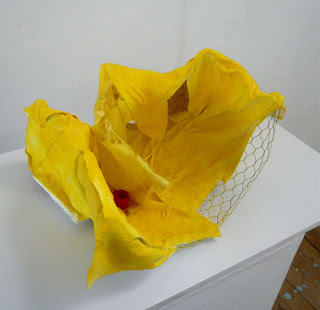
This year, my practice has maintained a strong attachment to materials and experimentation. For the MA show, instead of developing these experiments into a different work, I have decided that it is the original experiment itself that is the most significant element of my practice.
Upon discussion, for the four artists involved in the MA programme, a loose strand of common issues and emotions in our work is an understanding and knowledge of the world around us is gained through the process of making and looking. Though delving into these explorations may not provide answers, it is the stimulus for questions and discussion. This abstract way of approaching our practices together as one show led to the title Just to Say, expressing our need to put an idea/ feeling out for interpretation.
In exploring using my experiments for a final work, a particular point of reference is the Eva Hesse
Studiowork exhibition. This was an exhibition of her studio experiements, which Hesse described as ‘samples’. I enjoyed parts of how this collection of eccletic objects were displayed and felt that where they worked most successfully was as displayed below as the viewer could really get a ‘feel’ for the works, in the sense of their materiality and complexity.
Areas of the exhibition that were less successful were where they were contained in museum style glass cases, this gave them the air of being relics and also distanced the viewer from the works, making the feel of the materials less alive and tactile. I believe Hesse’s work is presented best as it was made and not curatorially controlled. This is something that is important in my own work, giving my experiements a life out of the confines of the studio I want to encourage interactivity from the viewer in order for them to gain a sense of the constructing of the work and of the enjoyment of making it.
Layout of ECA E25..
To begin with, the physical nature of our individual works dictated their display more than conceptual linkage. Catriona Reid’s work is site-specific within her chosen areas of the college, Lindsey Fyfe’s work is two-dimensional displayed on well-lit walls and Diane Melot is a film maker so she makes use of the projection room. My work, being sculptural, operated well in the main body of the room; in order to be viewed from all angles and perspectives.
We will curate the show in order so the works are not merging but to rather to reflect juxtapositions as well as gain an overall sense of unity as a show. For example, placing my crude objects next to Lindsey Fyfe’s refined and formal will heighten a sense of juxtaposition through textures and surface; however, this also builds an affinity between the works as Lindsey Fyfe’s grid formation paintings fit well next to the geometric structured bases of my sculptural work. Upon detailed observation, what initially appears to be disorder in my work actually is balanced out through strict structured display and in Fyfe’s paintings; the repeated formal lines on close inspection actually reveal hints of wiggles and the hand of the artist: a subtle touch of chaos. Additionally, both Catriona Reid’s banister wall drawing and Diane Melot’s string sink work have a similar play with lines and levels as well as being playful and suggestive of a continuing experience, both achieved through differing technique and materials.














































